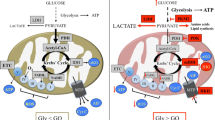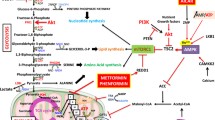Abstract
Although the “Warburg effect”, i.e., elevated glucose metabolism to lactic acid (glycolysis) even in the presence of oxygen, has been recognized as the most common biochemical phenotype of cancer for over 80 years, its biochemical and genetic basis remained unknown for over 50 years. Work focused on elucidating the underlying mechanism(s) of the “Warburg effect” commenced in the author’s laboratory in 1969. By 1985 among the novel findings made two related most directly to the basis of the “Warburg effect”, the first that the mitochondrial content of tumors exhibiting this phenotype is markedly decreased relative to the tissue of origin, and the second that such mitochondria have markedly elevated amounts of the enzyme hexokinase-2 (HK2) bound to their outer membrane. HK2 is the first of a number of enzymes in cancer cells involved in metabolizing the sugar glucose to lactic acid. At its mitochondrial location HK2 binds at/near the protein VDAC (voltage dependent anion channel), escapes inhibition by its product glucose-6-phosphate, and gains access to mitochondrial produced ATP. As shown by others, it also helps immortalize cancer cells, i.e., prevents cell death. Based on these studies, the author’s laboratory commenced experiments to elucidate the gene basis for the overexpression of HK2 in cancer. These studies led to both the discovery of a unique HK2 promoter region markedly activated by both hypoxic conditions and moderately activated by several metabolites (e.g., glucose), Also discovered was the promoter’s regulation by epigenetic events (i.e., methylation, demethylation). Finally, the author’s laboratory turned to the most important objective. Could they selectively and completely destroy cancerous tumors in animals? This led to the discovery in an experiment conceived, designed, and conducted by Young Ko that the small molecule 3-bromopyruvate (3BP), the subject of this mini-review series, is an incredibly powerful and swift acting anticancer agent. Significantly, in subsequent experiments with rodents (19 animals with advanced cancer) Ko led a project in which 3BP was shown in a short treatment period to eradicate all (100%). Ko’s and co-author’s findings once published attracted global attention leading world-wide to many other studies and publications related to 3BP and its potent anti-cancer effect. This Issue of the Journal of Bioenergetics and Biomembranes (JOBB 44-1) captures only a sampling of research conducted to date on 3BP as an anticancer agent, and includes also a Case Report on the first human patient known to the author to be treated with specially formulated 3BP. Suffice it to say in this bottom line, “3BP, a small molecule, results in a remarkable therapeutic effect when it comes to treating cancers exhibiting a “Warburg effect”. This includes most cancer types.
Similar content being viewed by others
References
Bustamante E, Pedersen PL (1977) Proc. Natl Acad Sci (USA) 74:3735–3739
Bustamante E, Morris HP, Pedersen PL (1981) J Biol Chem 256:8699–8704
Cardaci S, Desideri E, Ciriolo R (2012) J Bioenerg Biomemb 44:17–29
Davidescu M, Sciaccaluga M, Maccchioni L, Agelina R, Lopalco P, Rambotti MG, Roberti R, Corcelli A, Castigli E, Corazzi L (2012) J Bioenerg Biomemb 44:51–60
El Sayed SM, Abou El-Magd RM, Shishido Y, Chung SP, Diem TH, Sakai T, Watanabe H Kagami S, Fukui K (2012) J Bioenerg Biomemb 44:51–60
Gatenby RA, Gawlinski ET (2003) Cancer Res 63:3847–3854
Goel A, Mathupala SP, Pedersen PL (2003) J Biol Chem 278:15333–15340
Hayat MJ, Howlader N, Reichman ME, Edwards BK (2007) Oncologist 12:20–37
Icard P, Zhang X-D, Lemoisson E., Louis M-H, Allouche S, Lincet H, Laurent P (2012) J Bioenerg Biomemb 44:81–90
Kennedy EP, Lehninger AL (1949) Lehninger Al. J Biol Chem 179:957–972
Ko YH, Geschwind JF, Pedersen PL (2001) Can Lett 173:83–91
Ko YH, Smith BL, Wang Y, Pomper MG, Rini DA, Torbenson MS, Hullihen J, Pedersen PL (2004) Biochem Biophys Res Commun 324:269–275
Ko YH, Verhoeven HA, Lee MJ, Corbin DJ, Vogl TJ, Pedersen PL (2012) J Bioenerg Biomemb 44:149–156
Lee MG, Pedersen PL (2003) J Biol Chem: 278:41047–41058
Lis P, Zarzycki M, Ko YH, Casal M, Pedersen PL, Goffeau A, Ulaszewski S (2012) J Bioenerg Biomemb 44:141–147
Mathupala SP, Rempel A, Pedersen PL (2001) J Biol Chem 276:43407–43412
Mathupala SP, Ko YH, Pedersen PL (2009) Semin Cancer Biol 19:17–24
Mathupala SP, Ko YH, Pedersen PL (2010) Biochim Biophys Acta 1797:1225–1230
Nakano A, Miki H, Nakamura S, Harada T, Oda A, Amou H, Fujii S, Kagawa K, Takeuchi K, Ozaki S, Matsumoto T, Abe M (2012) J Bioenerg Biomemb 44:31–38
Nakashima RA, Mangan PS, Colombini M, Pedersen PL (1986) Biochemistry 25:1013–1021
Pastorino JB, Shulga N, Hoek JB (2002) J Biol Chem 277:7610–7618
Pedersen PL, Eska T, Morris HP (1971) Catterall WA. Proc Natl Acad Sci (USA) 68:1079–1082
Queiros O, Preto A, Pacheco A, Pinheiro C, Azevedo-Silva J, Moreira R, Pedro M., Ko YH, Pedersen P, Baltazar F, Casal M (2012) J Bioenerg Biomemb 44:127–139
Rempel A, Mathupala SP, Griffin CA, Hawkins AL, Pedersen PL (1996) Cancer Res 56:2468–2471
Robey RB, Hay N (2005) Hay N 4:654–658
Rodrigues-Ferreira C, Pereira da Silva, Galina A (2012) J Bioenerg Biomemb 44:39–49
Schreiber JR, Balcavage WX, Morris HP, Pedersen PL (1970) Cancer Res 30:2497–2501
Shosan MC (2012) J Bioenerg Biomemb 44:7–15
Tang Z, Yuan S, Hu Y, Zhang H, Wu W, Zeng Z, Yang J, Yun J, Xu R, Huang P (2012) J Bioenerg Biomemb 44:117–125
Verhoeven HA,van Griensven LJLD (2012) J Bioenerg Biomemb 44:91–99
Warburg O (1930) Metabolism of tumors. Arnold Constable, London
Warburg O (1956) On the origin of cancer cells. Science 24:300–314
Yu SJ, Yoon J-H, Yang J-I, Cho EJ, Kwak MS, Jang ES, Lee J-H, Kim YJ, Lee H-S, Kim CY (2012) J Bioenerg Biomemb 44:101–115
Author information
Authors and Affiliations
Corresponding author
Additional information
Much of the work described herein that related to work of PLP and co-workers was supported by NIH grants CA l0951 and CA 80018.
Work spearheaded by Young Ko showing the capacity of the anticancer agent 3BP to eradicate cancerous tumors in animals can be viewed in a seminar presented by PLP at the NIH. (Permanent link: http://videocast.nih.gov/launch.asp?14962)
Rights and permissions
About this article
Cite this article
Pedersen, P.L. 3-bromopyruvate (3BP) a fast acting, promising, powerful, specific, and effective “small molecule” anti-cancer agent taken from labside to bedside: introduction to a special issue. J Bioenerg Biomembr 44, 1–6 (2012). https://doi.org/10.1007/s10863-012-9425-4
Published:
Issue Date:
DOI: https://doi.org/10.1007/s10863-012-9425-4




